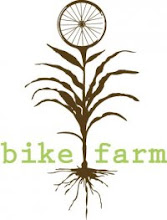the entire plan document can be downloaded in not exactly bite-sized chunks or in its 32.2MB entirety from PBoT's website. for me, the important stuff is what exactly are they proposing to put on the ground and to what extent will i be required to use it if i find it not to my liking (as for example the green box).
the first thing that strikes me in reading through the plan is the repeated emphasis on "separated in-roadway bikeways," meaning, cycletracks and buffered bike lanes, on roads on which motor traffic volumes (not speeds, but volumes) are high.
on lower volume streets, the plan talks in terms of "shared" facilities, including bike boulevards and "signage and markings" (presumably including "sharrows," though these are nowhere mentioned except in appendix D, among a catalogue of "best practices," including pretty much the kitchen sink), and "advisory" bike lanes with dashed striping, which would in effect create a single lane down the middle of a narrow sidestreet for motor traffic, with bikes to the sides. very low volume and low speed.
[there is also a somewhat disturbing insistence on treating off-road, multi-use paths as part of the "bikeway system," to the extent of recommending that the phrase "off-street path" no longer be used. newspeak.]
but when it gets right down to "strategic implementation" of the plan, it turns out that the "immediate" push (in the first five years) will be for more "shared" facilities, primarily bike boulevards. experimentation with cycletracks and other "separated in-roadway" stuff is treated as secondary. in terms of mileage, the proposed "shared" facilities outdistance the "separated in-roadway" projects more than two to one.
in the first five years.
in the outlying years, however, the proportion flips dramatically, so that by 2030 fully half of what they are proposing to build will be "separated in-roadway." even though they acknowledge that these are experimental. so in theory they cannot know now how much of this they will want to build twenty years out.
but on another somewhat disturbing note, they twice refer to the green bike box experiment as a "success," though the data are not really in yet and seem at best equivocal. this may portend that the conclusions are foregone.
anyway, short term, more bike boulevards, more signage, maybe some sharrows. all good. that's one.
and then deep in part four, "programs to support bicycling," in section 4.2D, "implement enforcement practices that contribute to the safety and attractiveness of bicycling," they talk about "develop[ing] a strategy" among PBoT, the city attorney, the police bureau, other bureaus, and "community groups" (including whom?), quote:
to interpret unclear state laws pertaining to safe bicycling and develop possible legislative changes to clarify or improve existing laws, including the following considerations:
Safe passing distance
When a bicyclist may leave a bike lane
When a motorist may enter a bike lane
Stop sign requirements
Yield requirements
Bicycle lighting equipment
Culpability for non-reckless drivers
end quote.
i want to think this means, among other things, that PBoT is open to engaging on the question of repealing the far to right and mandatory sidepath statutes. at the very least, it seems as though PBoT is suggesting a reasonably clear policy of non-enforcement. there is some evidence that roger geller, at least, "gets" this.
in any event, i am grasping at this as the second of my two reasons to support the 2030 plan, and i intend to be vocal in pushing for implementation of section 4.2D.
so that's two.
oh, and in section 4.2B, "increase safety education," they talk about working with ODoT and the state legislature "to achieve local control in setting speed limits." that's actually three.
so, okay, yeah, build it.





